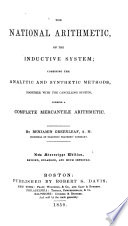 | Benjamin Greenleaf - 1847 - 336 pages
...miles, 2 rods. PROBLEM III. Given the extremes and the common difference, to find the number of terms. 1 RULE. Divide the difference of the extremes by the common difference, and the quotient increased by one, will be the number of terms required 9. Tf the extremes are 3 and 45,... | |
 | Pliny Earle Chase - 1848 - 244 pages
...5, gives 7, which must be equal to the number of terms less 1. Therefore the number of terms is 8. RULE. Divide the difference of the extremes by the common difference, and add 1 to the quotient. 13. What is the sum of the series 2, 4, 6, 8, &c., to 1000? 14. What is the sum... | |
 | J. M. Scribner - 1849 - 286 pages
...required the common difference. 29-3=26 ; and 26-M3=2. Ans. Gicen the Common Difference and the Extremes, to find the Number of Terms. Rule. — Divide the...difference of the extremes by the common difference, and to the quotient add one. Example. — The first term of an arithmetical progression is 11, the last... | |
 | Nathan Daboll, David Austin Daboll - 1849 - 260 pages
...and the number of terms 140.) CASE IV. The first term, last term and common difference given, to Jind the number of terms. RULE. Divide the difference of the extremes by the common difference, and the quotient increased by 1, will be the number of terms. EXAMPLES. 1 . A man bought cloth in arithmetical... | |
 | George Roberts Perkins - 1849 - 344 pages
...the first term, the last term, and the common difference, to find the number of terms, we have this RULE. Divide the difference of the extremes by the common difference, and to the quotient add one. EXAMPLES. 1. The first term of an arithmetical progression is 5, the last... | |
 | Benjamin Greenleaf - 1849 - 388 pages
...the extremes, and the product divided by 2, the quotient would be the sum of the series. RULK. — Divide the difference of the extremes by the common difference, and add 1 to the quotient ; multiply this quotient by the sum of the extremes, and half the product is the... | |
 | Benjamin Greenleaf - 1849 - 336 pages
...of differences ; therefore, 9 -j- 1 = 10, is the number of terms in this series. Hence the following RULE. — Divide the difference of the extremes by the common difference, and the quotient, increased by 1, will be the number of terms required. EXAMPLES FOR PRACTICE. 1. If the... | |
 | Charles Guilford Burnham - 1850 - 350 pages
...purchased. Therefore — Art. 239. — When the first and last terms, and the common difference are given, to find the number of terms — RULE. Divide the difference of the extremes by the common difference, and the quotient will be 1 less than the number of terms. 10. If the first term of a series be 2, and the... | |
 | Benjamin Greenleaf - 1850 - 368 pages
...Problem I. that the number of terms is one more than the number of differences ; therefore 8 -(- 1 = 9, the number of terms. RULE. — Divide the difference of the extremes by the common difference, and the quotient increased by one will be the number of terms required. 9. If the extremes are 3 and 45,... | |
 | George Roberts Perkins - 1850 - 356 pages
...the first term, the last term, and the common difference, to find the number of terms, we have this RULE. Divide the difference of the extremes by the common difference, and to the quotient add one. EXAMPLES. 1. The first term of an arithmetical progression is 5, the last... | |
| |